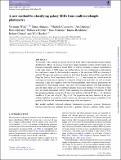A new method for classifying galaxy SEDs from multiwavelength photometry
View/
Date
11/05/2014Author
Funder
Grant ID
ERC-2012-StG-20111012
Keywords
Metadata
Show full item recordAbstract
We present a new method to classify the broad-band optical–near-infrared spectral energy distributions (SEDs) of galaxies using three shape parameters (super-colours) based on a principal component analysis of model SEDs. As well as providing a compact representation of the wide variety of SED shapes, the method allows for easy visualization of information loss and biases caused by the incomplete sampling of the rest-frame SED as a function of redshift. We apply the method to galaxies in the United Kingdom Infrared Telescope Infrared Deep Sky Survey Ultra Deep Survey with 0.9 < z < 1.2, and confirm our classifications by stacking rest-frame optical spectra for a fraction of objects in each class. As well as cleanly separating a tight red sequence from star-forming galaxies, three unusual populations are identifiable by their unique colours: very dusty star-forming galaxies with high metallicity and old mean stellar age; post-starburst galaxies which have formed ≳10 per cent of their mass in a recent unsustained starburst event; and metal-poor quiescent dwarf galaxies. We find that quiescent galaxies account for 45 per cent of galaxies with log M*/M⊙ > 11, declining steadily to 13 per cent at log M*/M⊙ = 10. The properties and mass function of the post-starburst galaxies are consistent with a scenario in which gas-rich mergers contribute to the growth of the low- and intermediate-mass range of the red sequence.
Citation
Wild , V , Almaini , O , Cirasuolo , M , Dunlop , J , McLure , R , Bowler , R , Ferreira , J , Bradshaw , E , Chuter , R & Hartley , W 2014 , ' A new method for classifying galaxy SEDs from multiwavelength photometry ' , Monthly Notices of the Royal Astronomical Society , vol. 440 , no. 2 , pp. 1880-1898 . https://doi.org/10.1093/mnras/stu212
Publication
Monthly Notices of the Royal Astronomical Society
Status
Peer reviewed
ISSN
0035-8711Type
Journal article
Description
VW acknowledges support from the European Research Council Starting Grant (PI: V. Wild), European Research Council Advanced Grant (PI: J. Dunlop) and European Career Re-integration Grant (PI: V. Wild). JSD acknowledges support from the European Research Council Advanced Grant (PI: J. Dunlop). RM acknowledges support from the European Research Council Consolidator Grant (PI: R. McLure). JSD also acknowledges the contribution of the EC FP7 SPACE project ASTRODEEP (Ref. No: 312725). This work was supported in part by the National Science Foundation under Grant No. PHYS-1066293.Collections
Items in the St Andrews Research Repository are protected by copyright, with all rights reserved, unless otherwise indicated.
Related items
Showing items related by title, author, creator and subject.
-
SDSS-IV MaNGA: How the stellar populations of passive central galaxies depend on stellar and halo mass
Oyarzún, Grecco A.; Bundy, Kevin; Westfall, Kyle B.; Tinker, Jeremy L.; Belfiore, Francesco; Argudo-Fernández, Maria; Zheng, Zheng; Conroy, Charlie; Masters, Karen L.; Wake, David; Law, David R.; McDermid, Richard M.; Aragón-Salamanca, Alfonso; Parikh, Taniya; Yan, Renbin; Bershady, Matthew; Sánchez, Sebastián F.; Andrews, Brett H.; Fernández-Trincado, José G.; Lane, Richard R.; Bizyaev, D.; Boardman, Nicholas Fraser; Lacerna, Ivan; Brownstein, J. R.; Drory, Niv; Zhang, Kai (2022-07-06) - Journal articleWe analyze spatially resolved and co-added SDSS-IV MaNGA spectra with signal-to-noise ratio ∼100 from 2200 passive central galaxies (z ∼ 0.05) to understand how central galaxy assembly depends on stellar mass (M*) and halo ... -
Secular-and merger-built bulges in barred galaxies
Mendez Abreu, Jairo; Debattista, V. P.; Corsini, E. M.; Aguerri, J. A. L. (2014-12) - Journal articleContext. Historically, galaxy bulges were thought to be single-component objects at the center of galaxies. However, this picture is now questioned since different bulge types with different formation paths, namely classical ... -
Galaxy And Mass Assembly (GAMA) : galaxy close pairs, mergers and the future fate of stellar mass
Robotham, A. S. G.; Driver, S. P.; Davies, L. J. M.; Hopkins, A. M.; Baldry, I. K.; Agius, N. K.; Bauer, A. E.; Bland-Hawthorn, J.; Brough, S.; Brown, M. J. I.; Cluver, M.; De Propris, R.; Drinkwater, M. J.; Holwerda, B. W.; Kelvin, L. S.; Lara-Lopez, M. A.; Liske, J.; Lopez-Sanchez, A. R.; Loveday, J.; Mahajan, S.; McNaught-Roberts, T.; Moffett, A.; Norberg, P.; Obreschkow, D.; Owers, M. S.; Penny, S. J.; Pimbblet, K.; Prescott, M.; Taylor, E. N.; van Kampen, E.; Wilkins, S. M. (2014-11-11) - Journal articleWe use a highly complete subset of the Galaxy And Mass Assembly II (GAMA-II) redshift sample to fully describe the stellar mass dependence of close pairs and mergers between 10(8) and 10(12)M(circle dot). Using the analytic ...

